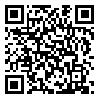Volume 5, Issue 1 (Spring and Summer 2019)
JMIS 2019, 5(1): 12-20 |
Back to browse issues page
Download citation:
BibTeX | RIS | EndNote | Medlars | ProCite | Reference Manager | RefWorks
Send citation to:



BibTeX | RIS | EndNote | Medlars | ProCite | Reference Manager | RefWorks
Send citation to:
Golabchi A, Sokot Arani S, Mousavi G, Sadeghi Gandomani H, Meydani Z. Comparison of the effect of video- training based technique by video and group discussion on the level of stress, anxiety, depression and self-efficacy of patients undergoing pacemaker and cardiac implantation defibrillator. JMIS 2019; 5 (1) :12-20
URL: http://jmis.hums.ac.ir/article-1-177-en.html
URL: http://jmis.hums.ac.ir/article-1-177-en.html
Allahyar Golabchi 

 , Sareh Sokot Arani
, Sareh Sokot Arani 

 , Gholamabbas Mousavi
, Gholamabbas Mousavi 
 , Hamidreza Sadeghi Gandomani
, Hamidreza Sadeghi Gandomani 
 , Zahra Meydani
, Zahra Meydani 



 , Sareh Sokot Arani
, Sareh Sokot Arani 

 , Gholamabbas Mousavi
, Gholamabbas Mousavi 
 , Hamidreza Sadeghi Gandomani
, Hamidreza Sadeghi Gandomani 
 , Zahra Meydani
, Zahra Meydani 

Medical Student Research Committee, Kashan University of Medical Sciences, Kashan, Iran.
Abstract: (5480 Views)
Aim: Lack of knowledge about cardiac implantation pacemaker and defibrillator can lead to stress and anxiety in patients. The aim of this study was to compare the effect of group and video training on the level of stress, anxiety, depression and self-efficacy in patients with pacemaker implantation and cardiac implantation defibrillator in 2017.
Methods: In this clinical trial, 105 patients were randomly assigned to three groups of 35 (group discussion, video, and control). The same educational content was presented to the intervention team in the form of group discussion and video (compact disc). Data were collected using a demographic questionnaire, a DASS21 questionnaire, and cardiac self-efficacy of ICD patients before and three weeks after training in all three groups. Data were analyzed using spss16 software.
Results: The difference between the scores of stress and depression before and after education was not significant in the three educational groups (P-Value=0.55 and 0.85), but the difference between the scores of anxiety and self-efficacy of the patients before and after the training in three significant groups was. Also, self-efficacy of patients with ICD in group training, video, group, control, video and control group was significant (P-Value = 0.009, 0.122, and 0.001, respectively).
Conclusion: Applying educational methods can lead to control of the psychological symptoms of patients and promote their level of self-efficacy. Hence, it would be better to use less costly teaching methods, such as video tutorials for patient education.
Methods: In this clinical trial, 105 patients were randomly assigned to three groups of 35 (group discussion, video, and control). The same educational content was presented to the intervention team in the form of group discussion and video (compact disc). Data were collected using a demographic questionnaire, a DASS21 questionnaire, and cardiac self-efficacy of ICD patients before and three weeks after training in all three groups. Data were analyzed using spss16 software.
Results: The difference between the scores of stress and depression before and after education was not significant in the three educational groups (P-Value=0.55 and 0.85), but the difference between the scores of anxiety and self-efficacy of the patients before and after the training in three significant groups was. Also, self-efficacy of patients with ICD in group training, video, group, control, video and control group was significant (P-Value = 0.009, 0.122, and 0.001, respectively).
Conclusion: Applying educational methods can lead to control of the psychological symptoms of patients and promote their level of self-efficacy. Hence, it would be better to use less costly teaching methods, such as video tutorials for patient education.
Type of Study: Research |
Subject:
General
Received: 2019/04/26 | Accepted: 2019/08/11 | Published: 2019/09/15
Received: 2019/04/26 | Accepted: 2019/08/11 | Published: 2019/09/15
Send email to the article author
| Rights and permissions | |
 |
This work is licensed under a Creative Commons Attribution-NonCommercial 4.0 International License. |




 hums.ac.ir
hums.ac.ir